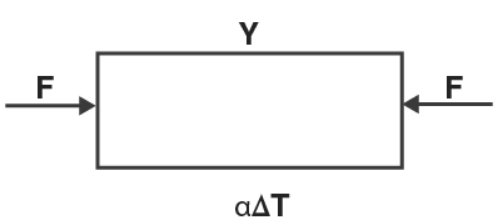Answer
64.8k+ views
Hint:As we know the young’s modulus is stress divided by strain so start with the relation between the thermal stress and length of the rod. Then try to find out thermal stress and hence we will get the required relation between force applied, area of cross section, increase in temperature coefficient of thermal expansion and young’s modulus.
Formula used:
\[\Delta l=\dfrac{Fl}{AY}\]
Where Y is the young’s modulus of the rod, l is the length of the rod, F is the force on the rod and A is its cross sectional area.
$\Delta l=\alpha l\Delta T$
$\Delta l$ is the change in length or the elongation, l is the original length and $\Delta T$ is the change in temperature
Complete step by step solution:
Here two equal forces F are applied on the rod from the opposite direction which will cause compression in the rod and temperature is increased by $\Delta T$ which will cause expansion in the rod.
Now we have, first change in length caused by forces applied,
$\Delta l = \dfrac{{Fl}}{{Ay}}$...........(equation 1)
Second change in length caused by increase in temperature,
$\Delta l = l\alpha \Delta T$.........(equation 2)
Since the length of the rod does not change this implies change in length caused by both the force and temperature balance each other. Then we can equate the equations 1 and 2.
By equating both the equation, we get;
\[\dfrac{{Fl}}{{Ay}} = l\alpha \Delta T\]
By further solving we get;
$\therefore y = \dfrac{F}{{A\alpha \Delta T}}$
Hence the correct answer is option B.
Note: In case the change in length of the rod is not same in both the cases that is by force applied and increase in temperature then we cannot equate both the equations. Also be careful about the direction in which the force is applied on the rod if this changes the whole equation will get changed.
Formula used:
\[\Delta l=\dfrac{Fl}{AY}\]
Where Y is the young’s modulus of the rod, l is the length of the rod, F is the force on the rod and A is its cross sectional area.
$\Delta l=\alpha l\Delta T$
$\Delta l$ is the change in length or the elongation, l is the original length and $\Delta T$ is the change in temperature
Complete step by step solution:
Here two equal forces F are applied on the rod from the opposite direction which will cause compression in the rod and temperature is increased by $\Delta T$ which will cause expansion in the rod.
Now we have, first change in length caused by forces applied,
$\Delta l = \dfrac{{Fl}}{{Ay}}$...........(equation 1)
Second change in length caused by increase in temperature,
$\Delta l = l\alpha \Delta T$.........(equation 2)
Since the length of the rod does not change this implies change in length caused by both the force and temperature balance each other. Then we can equate the equations 1 and 2.
By equating both the equation, we get;
\[\dfrac{{Fl}}{{Ay}} = l\alpha \Delta T\]
By further solving we get;
$\therefore y = \dfrac{F}{{A\alpha \Delta T}}$
Hence the correct answer is option B.
Note: In case the change in length of the rod is not same in both the cases that is by force applied and increase in temperature then we cannot equate both the equations. Also be careful about the direction in which the force is applied on the rod if this changes the whole equation will get changed.
Recently Updated Pages
Write a composition in approximately 450 500 words class 10 english JEE_Main

Arrange the sentences P Q R between S1 and S5 such class 10 english JEE_Main

What is the common property of the oxides CONO and class 10 chemistry JEE_Main

What happens when dilute hydrochloric acid is added class 10 chemistry JEE_Main

If four points A63B 35C4 2 and Dx3x are given in such class 10 maths JEE_Main

The area of square inscribed in a circle of diameter class 10 maths JEE_Main

Other Pages
Excluding stoppages the speed of a bus is 54 kmph and class 11 maths JEE_Main

In the ground state an element has 13 electrons in class 11 chemistry JEE_Main

Electric field due to uniformly charged sphere class 12 physics JEE_Main

A boat takes 2 hours to go 8 km and come back to a class 11 physics JEE_Main

According to classical free electron theory A There class 11 physics JEE_Main

Differentiate between homogeneous and heterogeneous class 12 chemistry JEE_Main




